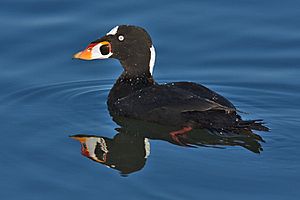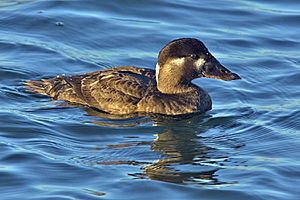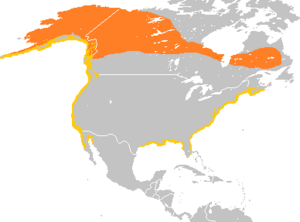Surf scoter facts for kids
Quick facts for kids Surf scoter |
|
|---|---|
 |
|
| Adult male | |
 |
|
| Adult female | |
| Conservation status | |
| Scientific classification | |
| Genus: |
Melanitta
|
| Species: |
perspicillata
|
 |
|
| Range of M. perspicillata Breeding range Wintering range | |
| Synonyms | |
|
Anas perspicillata Linnaeus, 1758 |
|
The surf scoter (Melanitta perspicillata) is a large sea duck that lives in North America. These ducks are known for their unique look. Adult males are mostly black with cool white patches on their heads. Females are a bit smaller and browner.
Surf scoters spend their summers breeding in northern Canada and Alaska. When winter comes, they fly south. They spend the colder months along the Pacific and Atlantic coasts of North America. These diving ducks love to eat small creatures that live on the seafloor, especially mussels.
Contents
What is a Surf Scoter?
Surf scoters are a type of sea duck. They are known for their strong diving skills. They can dive deep underwater to find food. These birds are part of a group called Melanitta. This group includes five different kinds of scoters.
How are Surf Scoters Classified?
The famous scientist Carl Linnaeus first described the surf scoter in 1758. He gave it the scientific name Anas perspicillata. Anas is a Latin word for ducks. The second part, perspicillata, means "spectacled" in Latin. This refers to the white patches on its head that look like glasses.
Later, the surf scoter was moved to the Melanitta group. Melanitta comes from ancient Greek words meaning "black duck." The surf scoter is closely related to the white-winged scoter and the velvet scoter. These three are like close cousins in the duck family.
Physical Characteristics
Surf scoters are the smallest type of scoter. Adult males usually weigh about 1,050 grams (2.3 pounds). They are about 48 centimeters (19 inches) long. Females are a bit smaller, weighing around 900 grams (2.0 pounds) and measuring 44 centimeters (17 inches). Their wingspan is about 76-77 centimeters (29.9-30.3 inches).
Male and Female Differences
Male surf scoters are easy to spot. They are completely black with bright white patches. One patch is on their forehead, and another is on the back of their neck. Their bill is large and colorful, with shades of orange, white, and yellow. It also has a black spot near the base.
Female surf scoters are mostly brown. They have lighter patches on their cheeks, below their eyes. Sometimes, they also have a whitish patch on the back of their neck. This neck patch is special among scoters. Their bill is black, sometimes with green or blue colors.
Young surf scoters look similar to females. However, they are usually paler and browner. Their chest and belly are whitish.
How to Tell Them Apart
It's easy to tell a surf scoter from other scoters. The male's white head patches and unique bill pattern are key. Females and young birds have a wider bill and a flatter head shape. This makes them look a bit like the common eider.
When flying, surf scoters are the only scoters with completely dark wings. This helps identify them in the air.
Molting and Feathers
Like all sea ducks, surf scoters cannot fly for a short time each year. This happens when they lose all their flight feathers at once. This period is called molting. It usually occurs in late July to early August and lasts about four weeks. During this time, they are very vulnerable.
Before losing their flight feathers, ducks change their body feathers. Males lose their bright colors and get duller feathers. These new feathers are called eclipse plumage. For male surf scoters, their feathers can help tell their age.
Where Surf Scoters Live
Surf scoters are special because they only breed in North America. Most of them nest in northern Canada and Alaska. After breeding, they fly to warmer places for the winter.
Most surf scoters spend winter along the Pacific and Atlantic coasts of North America. The Pacific coast has the most birds. Their winter home stretches over 5,000 kilometers (3,100 miles). It goes from the Aleutian Islands in Alaska all the way to the Baja Peninsula in Mexico. A few surf scoters also fly to western Europe for the winter.
Their Homes Throughout the Year
During the breeding season, surf scoters live in northern forests. They prefer areas near freshwater lakes. Their nests are usually on the ground, close to spruce trees and wet areas.
Before they migrate, they go to special molting sites. These sites are different from their breeding or wintering spots. Molting sites are usually in bays, inlets, or estuaries. They offer plenty of food and protection from predators.
In winter, surf scoters live in ocean habitats close to the shore.
Behavior and Life Cycle
Reproduction and Nesting
Surf scoters find their mates during winter or on their way to breeding grounds. Most pairs are formed before they arrive at their nesting sites. They often return to the same nesting areas year after year.
Nests are built from mid-May to early June. The female digs a bowl-shaped nest on the ground. She lines it with plants and soft down feathers. Nests are usually close to the sea, lakes, or rivers, in wooded or tundra areas.
Females lay about 5 to 9 eggs. Each egg weighs between 55–79 grams (1.9–2.8 ounces). The female sits on the eggs for about 28 to 30 days. All the eggs hatch around the same time.
After hatching, the mother duck leads her ducklings to a feeding area. This area is usually less than 2 meters deep and protected from strong winds. The ducklings start finding their own food right away. The mother leaves her young before they can fly, usually around 55 days old.
Young ducks gather in small groups before flying to their winter homes. They travel without the adult ducks. Studies show that many ducklings, about 55-65%, do not survive. This might be due to weather conditions after they hatch.
What Surf Scoters Eat
Surf scoters mainly eat small creatures that live on the seafloor. During breeding season, they eat different freshwater bugs. For the rest of the year, they eat marine animals. They often feed in large groups, sometimes with thousands of birds.
Important foods include crabs, shrimp, snail-like creatures, and small clams like mussels. In late winter and spring, they change their diet. They might eat larger crustaceans or Pacific herring eggs when fish are spawning.
Surf scoters are smart about finding food. They work harder to find food when it's scarce. As the season changes, they move to places where there is more food.
They usually catch their food underwater and swallow it whole. They seem to pick smaller clams, perhaps because they are easier to eat. They also choose slow-moving crustaceans.
Surf scoters use their eyes to find food. They can spot small prey in complex places like mussel beds. They can also see the siphons of clams sticking out of the sand. They are good at eating herring eggs without swallowing plants.
When diving for food, groups of surf scoters often dive at the same time. How long they stay underwater depends on the type of food, how much food there is, the season, and water depth. They dive longer for herring eggs, which are harder to catch than mussels.
Adult scoters dive for crabs and molluscs. Young ducklings eat different kinds of freshwater invertebrates.
Migration Journeys
Surf scoters have many different migration paths. The path they choose depends on where they nested. They might leave their wintering sites at different times. However, they all seem to arrive at their nesting sites around the same time. This means they adjust their travel plans to be ready for breeding.
Males tend to spend winter in the northern parts of the range. Females and younger birds often go to the southernmost areas. In spring, males and females fly together to their breeding grounds. They usually settle into their nesting sites within a week of arriving.
Sounds They Make
Surf scoters are usually quiet birds. Their calls are not very well known. During courtship, males make a gurgling sound and a quick "puk-puk." Females make a crow-like call to protect their young. When they are scared, surf scoters often make a sound like "guk." They make this sound while looking around quickly or flying away in a group.
Dangers and Threats
Studies on sea ducks have shown that diseases caused by parasites can be a big problem. One parasite, called Polymorphus spp., was found in dead surf scoters. This parasite can cause serious stomach problems and make the birds very thin.
Other causes of death include starvation, oil pollution, and injuries from guns or hitting structures. For example, in 1995, about 100 surf scoters died along the coast of California.
Predators like bald eagles, golden eagles, and weasels hunt surf scoters in ocean habitats. Scoters face more dangers in winter than during their molting period.
In November 2007, an oil spill in San Francisco harbor harmed and killed thousands of birds. Many of these birds were surf scoters, making up about 40% of the affected birds. Scientists were worried because surf scoter populations had already dropped by 50 to 70% over 40 years. This spill affected healthy adult birds, which could further reduce their numbers.
Conservation Status
The surf scoter has a very large range and a big population. Because of this, the IUCN (International Union for Conservation of Nature) lists it as a species of "Least Concern." This means they are not currently in danger of extinction.
Even though their numbers have seemed to decrease in recent years, the decline is not fast enough to put them in a more threatened category. The total number of surf scoters in the world is estimated to be between 250,000 and 1,300,000 birds.
Images for kids
See also
 In Spanish: Negrón costero para niños
In Spanish: Negrón costero para niños




